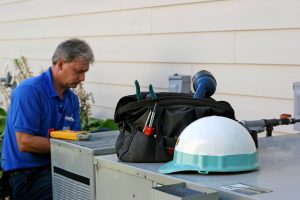Your air conditioner works tirelessly to keep you cool during the summer months. But have you ever wondered how it actually achieves that refreshing blast of cool air? The secret lies in two crucial components: the evaporator coil and the condenser coil. These coils work together in a fascinating dance of heat transfer, and understanding their roles can help you maintain a comfortable home and avoid costly repairs.
And don’t forget–these components require regular AC maintenance in Oakdale. Schedule your first appointment with us when you get the chance.
The Cooling Cycle: Two Coils Are Better Than One
Imagine your air conditioner as a closed-loop system that shuttles heat from inside your home to the outdoors. The evaporator coil, located indoors within the air handler unit, is the first stop on this journey. Made of metal tubes with heat-conducting fins, the evaporator coil acts like a sponge, absorbing heat from the air that’s blown over it by the blower fan.
As the heat transfers from the air to the refrigerant circulating within the evaporator coil’s tubes, the refrigerant itself undergoes a phase change. It evaporates from a liquid to a gas, absorbing the heat in the process. This is why the evaporator coil feels cold to the touch – it’s actively removing heat from the surrounding air.
The now-warmed refrigerant gas then travels through refrigerant lines to the outdoor condenser unit. Here’s where the condenser coil takes center stage. Unlike its indoor counterpart, the condenser coil is designed to release heat. It’s also constructed with metal tubes and fins, but situated in a way that maximizes exposure to outside air. A fan blows hot outdoor air across the condenser coil, causing the refrigerant gas to condense back into a liquid state. This condensation process releases the absorbed heat back into the external environment.
Evaporator Coil Problems
While the evaporator coil seems like a simple component, several issues can disrupt its ability to cool your home effectively. Here are some common evaporator coil problems to watch out for:
- Dirty Coil: Dust, dirt, and debris can accumulate on the evaporator coil’s fins, reducing airflow and hindering heat absorption. This leads to decreased cooling efficiency and higher energy bills. Regular maintenance is crucial for maintaining optimal performance.
- Frozen Coil: If the evaporator coil gets too cold, moisture in the air can condense and freeze on the coil’s surface. This ice buildup further restricts airflow and prevents proper heat transfer. A frozen coil can be caused by low refrigerant levels, clogged air filters, or a malfunctioning thermostat.
- Drain Line Clog: The condensate water extracted from the air needs to drain properly. A clogged drain line can lead to a buildup of water in the air handler unit, potentially damaging the evaporator coil and other components.
Condenser Coil Problems
Just like the evaporator coil, the condenser coil is susceptible to its own set of problems:
- Dirty Coil: Similar to the evaporator coil, a dirty condenser coil with clogged fins can impede airflow and reduce heat dissipation. This makes the air conditioner work harder to achieve the desired temperature, leading to increased energy consumption and potential wear and tear.
- Bent Fins: The condenser coil is located outdoors and exposed to the elements. Hail, wind-blown debris, or even accidental contact can bend the delicate fins. Bent fins disrupt airflow and reduce the coil’s efficiency.
Schedule an appointment or join the Love Club today by calling DeHart Plumbing, Heating, and Air Inc.


